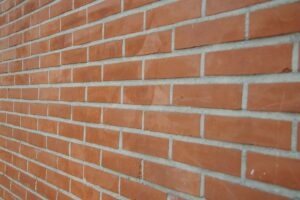Table of Contents
ToggleDiscover the critical differences between tuckpointing and repointing and how to ensure the longevity of your brickwork
So you’ve noticed some gaps in your mortar and are wondering if you should tuck-point or repoint. What is the distinction? Tuckpointing involves filling small mortar cracks with new material in order to restore them. On the contrary, repointing entails totally swapping out the old mortar with a fresh one.
This article will look at the differences between tuckpointing and repointing so you can determine the best technique for your deteriorating mortar. Let’s dive right in!
What is Tuckpointing?
- Tuckpointing is the process of patching up small mortar fissures using new mortar. Use the method to fix fractures caused by water seepage, stone deterioration, or expansion and contraction. It is only a temporary aesthetic remedy and won’t last as long as repointing. However, it is a less expensive and intrusive choice.
Maintaining your chimney can give you a gorgeous design element and possibilities for relaxing times by warm fires! However, you might not be aware that all masonry fireplaces eventually need to be repaired. This is a result of severe weather, either flooding or damage from moisture entering via damaged mortar joints.
- The good news is that tuckpointing is a useful technique. It has many advantages and stops this harmful process. When your house needs to be updated, you can take it into account.
When is Tuckpointing Required?
- Tuckpointing is required when there are cracks in the mortar. This restoration method’s primary goal is to fill in these gaps, so they are hidden from view. This will assist in keeping the building’s foundation sturdy and guarding it against additional harm.
Additionally, tuckpointing is important if any mortar needs to be added. This may happen as a result of normal aging or an effort to fix improperly done repairs from the past. In all scenarios, changing the mortar will guarantee that your chimney has a pleasant appearance and sturdy construction. Based on where cracks are apparent, you can put it either within or outside of your fireplace.
- Mortar has an average lifespan of 25 years. But if you’re in harsh conditions, you can cut it down to as little time as possible. Installing crickets to lessen water flow around the base is crucial for the health of your chimney. In this area, an abundance of precipitation may eventually lead to erosion and destruction.
How Frequently Should I Tuckpoint?
- Every three to five years, your fireplace should be tuck-pointed. The amount of weather exposure and the size of any created cracks will determine how frequently the mortar needs to be repaired.
The best technique to maintain your brick wall appearing old and genuine is by tuckpointing! However, it won’t stay as long. Consult Dupont Tuckpointing if you want to ensure that tucks last for ages rather than the typical 20 to 25 years that mortar applications last. We can determine by running our finger over any joints if we believe work needs to be done.
- Tuckpointing is the secret to preserving brick facades that would otherwise deteriorate over time. Failure to complete this important step could result in costly repairs as well as structural damage. Additionally, with some expert treatment from Dupont Tuckpointing, make those walls and chimneys look brand-new again.
What is Repointing?
- Repointing is the technique of using fresh mortar to replace old mortar. Do it right, and your chimney and fireplace constructions will be secure and reliable for many years to come.
Both inner and outdoor chimneys can be repointed. Maintaining fireplace structures is crucial. They are frequently exposed to challenging circumstances like water, moisture, angular impact, and temperature variation.
When is Repointing Required?
- When the mortar has been eroded away by exposure, repointing is required. It also becomes crucial when a repair is done improperly. Specialists also advise it when you see that the old mortar is soft or squishy. Simply put, it should sound sharp when you tap your knuckles against it while not using too much force.
The weakest aspect of the brickwork is the mortar joints since they are constantly exposed to the elements. Water can seep through the wall without repointing, eroding the bricks. This will result in structural damage and could collapse the chimney.
How Frequently Should I Repoint?
 Repointing a chimney takes time, and it may require several steps to do the task correctly. According to experts, the outside of your chimney should undergo this maintenance every three to seven years.
Repointing a chimney takes time, and it may require several steps to do the task correctly. According to experts, the outside of your chimney should undergo this maintenance every three to seven years.
Repointing is required after restoration and if the mortar joints start to break. Because they can result in significant issues, including damage to your fireplace and water leaks into your home, it is crucial also to remedy these.
- These two approaches accomplish the same thing. They are not, however, the same. Only specific parts of your structure’s mortar need to be replaced while tuckpointing. In repointing, the old mortar is completely replaced with fresh materials throughout the whole surface or wall portion.
Use this guide to determine whether tuckpointing or repointing is the right choice for your masonry. For more information, feel free to reach out to the experts at Dupont Tuckpointing!




